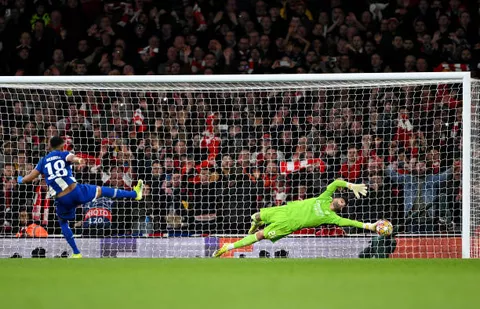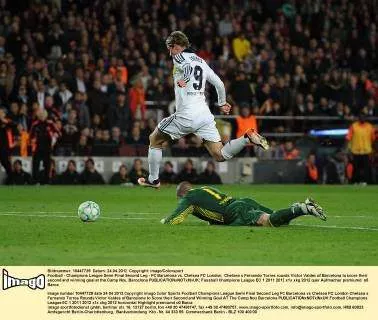
The away goals rule was scrapped from the Champions League in 2021, but how has the competition fared since its removal?
Porto's Brazilian midfielder Wenderson Galeno stood with the weight of the world on his shoulders, his penalty the only thing that stood between The Dragoes and elimination from the 2023/24. A rickety kick from the spot later, and Porto were indeed eliminated, Galeno denied by Arsenal's heroic goalkeeper David Raya, who had already denied Porto's Wendell earlier in the shootout.
Arsenal's progression to the quarterfinals of the Champions League for the first time in 14 years was also marked by some other curious Champions League milestones and facts.
Champions League Penalties On The Rise After Arsenal And Atletico Madrid Ties
The Gunners became the first side to win a Champions League match on penalties since Real Madrid beat neighbouring rivals Atletico Madrid in the final of the 2015/16, ending a run of eight years since the last penalty shootout in the competition.

Arsenal's Raya also set a competition record, becoming the first Gunners' goalkeeper with the most penalty shootout saves thanks to his performance against Porto. Raya saved "just" two penalties, but still outdid every other Arsenal goalkeeper in Champions League history. Not just in a single shootout, but throughout the course of their careers, emphasising the rarity of penalty duels in Europe's elite competition.
Yet, just one day after Arsenal's nerve-racking round of 16 decider, fans had to go through another nail-biting experience as Atletico Madrid were pushed all the way by Inter before triumphing via a penalty shootout.
A Previous Dearth Of Champions League Shootouts
The Rojiblancos' are somewhat specialists of the penalty shootout in the Champions League, having been involved in four of the last five shootouts in the competition's history, but even their participation shines a spotlight on how scarce a UCL shootout has been.
Atletico Madrid's four shootouts have come in a span of nine years since their victory on penalties against Bayer Leverkusen. In that time, there have been 135 knockout ties, and only five of them have gone to penalties. Indeed, only four of 126 two legged ties reached a penalty shootout, and the last time before the 2023/24 season that more than one two-legged tie went all the way was in the 2011/12 season.
When searching for the reason for this inherent lack of penalty shootouts in recent Champions League history, the now-defunct "Away goal" rule quickly comes to mind.
What Was The Away Goal Rule?
The away goals rule is a crucial aspect of deciding the winner in football matches that end in a draw after regular play. Typically utilized in two-legged ties like those in the Champions League knockout stages, this rule stipulates that goals scored away from home carry more weight. For instance, if the aggregate score is level after both legs, the team with more away goals is declared the winner.
To illustrate, if Team A loses 1-2 at home but wins 1-0 away in the second leg against Team B, Team B progresses thanks to having scored more away goals. However, if both teams score the same number of goals away from home or if neither team scores any away goals, the game proceeds to extra time or penalties to determine the winner.
Introduced in the 1965-66 Cup Winners Cup, the away goals rule aimed to eliminate the need for tie-breakers at neutral venues and incentivize teams to adopt an attacking approach when playing away from home. Since then, it has been adopted in various knockout tournaments worldwide, including the European Cup (now Champions League), becoming a fundamental part of football regulations for over half a century.
Why the Away Goals Rule Was Scrapped
In June 2021, the UEFA Executive Committee decided to eliminate the away goals rule from all UEFA club competitions, effective from the qualifying stages of the 2021/22 tournaments. This decision followed a recommendation from the UEFA Club Competitions Committee and the UEFA Women's Football Committee.

Consequently, ties where both teams score the same number of goals over two legs would no longer be decided based on away goals. Instead, two 15-minute periods of extra time will be played after the second leg. If the teams remain level or score no goals during this extra time, the winner will be determined through penalty kicks.
According to UEFA, Statistics spanning from the mid-1970s until 2021 revealed a notable trend in men's competitions, with a continual reduction in the disparity between home and away wins, as well as the average number of goals scored per match at home and away.

They reported that there had been a shift from home teams winning 61% of matches and away teams winning 19% to a more balanced distribution of 47% and 30%, respectively. Similarly, the average goals per game at home decreased from 2.02 to 1.58, while away goals increased from 0.95 to 1.15.
However, a look at recent trends suggest that teams have reverted to type following the dissolution of the away goal rule, wiping out decades of progress which UEFA reported as their reason for scrapping the rule in the first place.
How Teams Have Behaved Since The Scrapping Of The Away Goals Rule
While teams maintained their attacking gusto away from home in the first season after the abolition of the rule, with away teams winning a remarkable 41% of knockout matches in the Champions League, and home teams only winning only 31%, things have changed dramatically in the two seasons since, with teams now becoming less likely to attack away from home.
In the 2022/23 season for example, away teams won only 24% of knockout matches in the Champions League, less than half the 52% won by home teams.

With eight knockout matches played in the 2023/24 season, the numbers make for even more grim reading. Home teams have been victorious in an overwhelming 63% of matches (more than the initial numbers reported by UEFA from the 70s), while away teams have won only 19%.
The trend continues when goals scored are considered, as home teams in the current Champions League season have recorded 1.63 goals per game, compared to 0.75 goals per game for away teams.

While it may still be early days, the current trajectory suggests the removal of the away goal rule could have conditioned teams to employ tactics that necessitated the rule in the first place, calling into question the decision to do away with it in 2021.
With the Champions League set for an expansion in the 2024/25 season, fans could be met with dour ties where European minnows batten down the hatches away from home against the big wigs, instead of trying to find a goal that could "count as double," while more games run the risk of making it past 120 minutes and going to the lottery of penalties.
















Comments